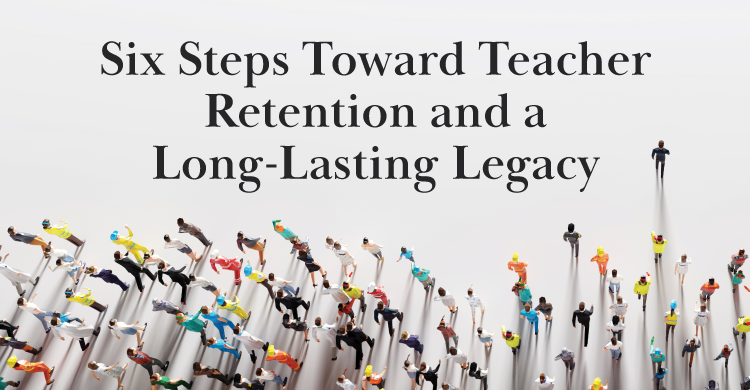Nothing Left to Give
When thinking about the landscape of education and how it has changed over the last few years, we can’t help but recognize the parallels between the selfless actions of our teachers and those of the iconic apple tree in the children’s book The Giving Tree by Shel Silverstein. The story tells of a boy and his best friend, an apple tree. Each day the boy visits the tree to spend time with it, play with it, and enjoy its company. However, as the boy grows older and faces the increasing demands and realities of growing up, his wants and needs begin to change. Because of this, the boy starts to take what he needs from the tree, initially only taking the tree’s apples but eventually taking its branches and finally its trunk, until the tree has literally nothing left to give.
As the wants and needs of our schools have changed over the past few years, so too have the demands and realities of our teachers. Between navigating staffing shortages, adapting to constantly changing learning models, and working on the front lines of a youth mental health crisis (Richtel, 2022), many of our teachers literally have nothing left to give, so much so that they are experiencing mental health concerns of their own and are considering leaving the profession entirely. Take, for example, a few of the findings from a recent survey conducted by the National Education Association (GBAO, 2022):
- 90 percent of educators consider burnout a serious problem.
- 91 percent of educators report they are seriously concerned about stress related to the pandemic.
- 55 percent of teachers are considering leaving education earlier than planned.
As educational leaders, it is our moral imperative to ensure we aren’t taking so much from our teachers that they have nothing left to give. If we want to keep our teachers in this noble profession, we must understand that the retention of our teachers is directly related to the support they receive.
Six Steps to Maximize Your Leadership Impact and Improve Teacher Retention
In our book Establishing a Lasting Legacy: Six Steps to Maximize Your Leadership Impact and Improve Teacher Retention, we explain how the school principal plays the vital yet humbling role of servant leader, placing the needs of their staff above their own and ultimately leaving a lasting impact on the beliefs, actions, and interactions of those they serve. Here are six critical steps you can take today to lift up your teachers and make a lasting difference in their lives.
Step One: Lead Authentically
You cannot lead others well until you have led yourself well, and that starts with aligning your actions with what you believe and value. Start by developing a power-up system in the morning where you have time to align yourself before you get to school. Your routine may consist of a quiet walk, listening to music, journaling, or reading a book. You can do the same at the end of your day by powering down. Reflect on what went right and what tweaks you need to make. Then, make a list of items to accomplish for the next day that will help you stay true to who you are and the kind of leader your teachers need.
Step Two: Build Teacher Self-Efficacy
Teachers feel support from their leader when their leader walks alongside them during stressful times. One sustainable way we can offer this support is through the development of teacher self-efficacy. Self-efficacy acts as a natural buffer between burnout and stress, meaning that even during times of stress and uncertainty, your teachers are less likely to burn out when they possess a strong belief in themselves and their abilities. As their leader, you can help develop your teachers’ self-efficacy when you get to know their D.N.A., or their desires, needs, and abilities. Ask:
-
- What personal and professional goals does this teacher have for themself and how can I add value to this person’s life so they will accomplish these goals?
- What are the specific social, emotional, and pedagogical needs of this teacher and what must I do to help meet these needs?
- What strengths does this teacher possess and how can I empower this teacher to use these strengths?
Step Three: Foster Collective Efficacy Among Your Staff
People work better in places where they feel valued and have a sense of belonging and community. Promote activities for an enjoyable work environment that build friendships, fun, and laughter. As staff get to know one another beyond day-to-day professional obligations, they will start to believe in the power of each other, fostering a sense of collective efficacy. It can help to build routines, traditions, and rituals around a set of three to five core values. Core values define who you are as a staff and what you are striving to become together. Emphasize those values when the staff is together. For example, some schools hold weekly staff huddles where staff members share a story honoring one of their colleagues and how they live the values on a daily basis.
Step Four: Cultivate a Culture of Trust
We build our school’s positive culture one relationship at a time. Cultivating trust takes an understanding of your teachers’ current situations and realities. At this moment in history, you may want to start in a place of healing for your staff. Many of your teachers may feel as if they didn’t sign up for the challenges they are currently facing. Acknowledge the extreme changes that have taken place and provide time for staff to process what they’ve been through. Too often leaders encourage their teachers to take care of themselves, focus on their own well-being, and find their own support for what they are dealing with. It can be quite hard for your teachers to do this when they have little left in their energy tanks. Instead, help them find the support that they need, being open and honest about your perception of what you see and willing to listen to their perception of how they feel. Kindness will serve as the glue that holds this movement together!
Step Five: Listen to Your Staff with Empathy
Successful communication involves the ability to listen to your people, helping them feel valued by giving them a voice. Principals who listen with empathy seek to understand another person’s perspective and circumstances. Formally emphasize your willingness to listen by setting up listening sessions with your staff. You can do this with an entire staff, with small groups, or in one-on-one sessions. Determine a topic and ask your staff to share their perceptions without your interruptions, rebuttals, or justifications. A small step like listening sessions will let others know they matter and that you have their best interest at heart.
Step Six: Unite Around a Shared Vision
A shared vision provides meaning and purpose for your teachers. Leaders who establish a shared vision unite staff around one common goal that embraces group differences. A shared vision that remains at the forefront of every conversation and interaction will influence staff performance, determine priorities deemed most important, and guide decisions made on a daily basis. Shared visions begin with you asking a series of questions designed to recognize each teacher’s experiences, needs, and hopes for the future. Personal vision commonalities are localized and a shared vision is established among your staff.
What Will They Say?
There is no doubt educators have faced immense challenges the last few years. The question is this: Have we supported them enough that at the end of the day they have something left to give? Or are they to the point where they are fully depleted, ready to leave the profession to find something that will add to their lives more than take away from them? When it’s all said and done, will your teachers say you’ve supported them by helping them believe in themselves and their capabilities? Will they say you’ve taught them that they are stronger together than apart? Will they say you’ve established a culture of care, centered on trust and empathy toward one another? Will they say you’ve left behind a shared vision and paved the way for future generations? Your legacy as a school leader exists within the teachers that continue teaching long after you’re gone. You’ll keep those teachers in the profession when you take one intentional, legacy-building step at a time.
Additional Information
To learn more, check out this video on the book Establishing a Lasting Legacy by Dr. Becky Evers-Gerdes and Dr. Ryan Siegle, which outlines six steps you can take to maximize your leadership impact, improve teacher retention, and leave a legacy that will impact those you serve for years to come.
Be a difference maker—the choice is yours!
Sources
Richtel, M. (2022, April 23). “It’s life or death”: The mental health crisis among U.S. teens. New York Times.
GBAO. (2022). Poll results: Stress and burnout pose threat of educator shortages. https://www.nea.org/sites/default/files/2022-02/NEA%20Member%20COVID-19%20Survey%20Summary.pdf






